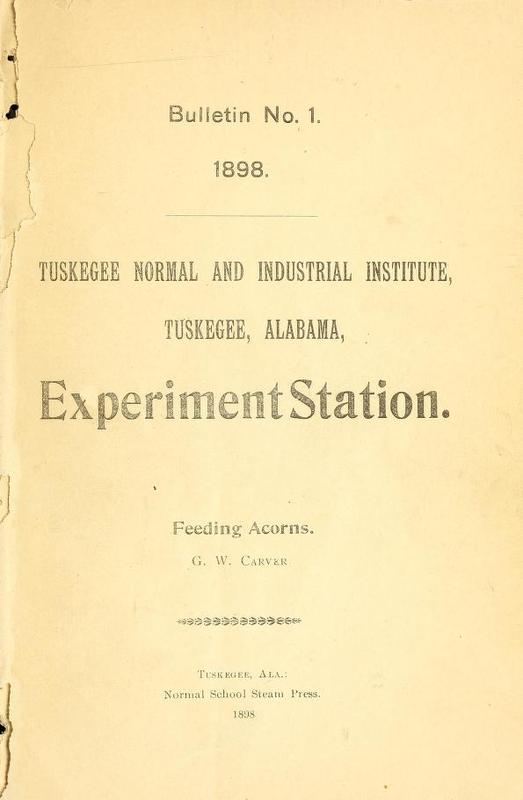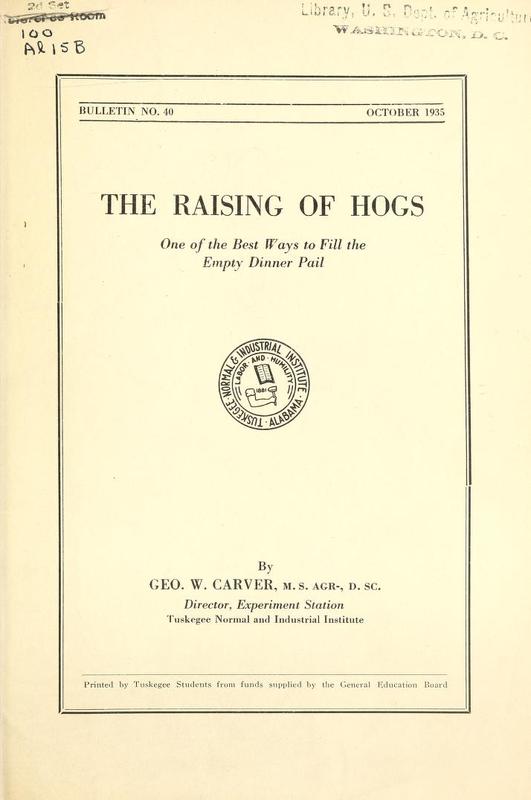Carver on Best Methods for Feeding Livestock
[T]he heart of Carver’s conservation ethic rested in his conviction that waste is anathema—a conviction that was rooted to a large degree in his understanding of ecological principles. Looking at the larger society of the South—and the nation—Carver concluded: ‘As a rule we are wasteful; we do not know how to save.’ For Carver, agriculture could be properly conducted (and, for that matter, natural resources could be wisely consumed) only with an abhorrence of waste. Thus, as farmers became aware of how the Creator had arranged the ‘mutual relationship of the animal, mineral and vegetable kingdoms,’ they could not help but recognize ways to make use of materials they had previously discarded or overlooked: swamp much would become fertilizer, the region’s clays dyes for whitewash and paint; cow pea vines might become animal fodder and tomato vines serve as a source of dyes for fabric; weeds would become vegetables, and corn shucks, rugs.
Hersey, M. (2006). "Hints and suggestions to farmers: George Washington Carver and rural conservation in the south." Environmental History, 11(2), pp. 251-252. Retrieved from: https://www.jstor.org/stable/3986231.
(Click any image in this exhibit to get more information, including access to full text)
"In this beautiful Southland of ours, with so many natural resources, and the repeated failures of the North, East and West to supply the ever-increasing demand for pork, dairy products, etc., has led us to turn much of our attention in this direction.
The great quantity of acorns produced in our oak forests, which have been hitherto practically a waste product, forms the subject of this Bulletin.
I presume that acorns have been used as an article of food ever since their production and that of the animals to eat them, and man has used them in a half-unconscious way, from the time America’s first settlers recognized the food value of the wild hog.
It did not take these sturdy colonists long to learn that the meat of the wild hog was fattest and sweetest when the mast (or acorns) were plentiful, as they were then and are now frequently called."
"Of all the get-rich-quick schemes there is probably none more productive of delusion than that of poultry raising on paper. And yet, with the proper facilities and applied intelligence, possibly more handsome returns can be had from poultry than any other industry in proportion to the amount of capital invested and the readiness with which results can be obtained.
There is an idea prevalent that poultry cannot be successfully raised in the South. This saying has been so oft repeated and the apparent truth so universally verified 1 that the majority of our people believe it and make but little or no effort to prove it false.
Years of costly experimentation and investigation have improved many of the apparent unsurmountable obstacles, so that there remains no doubt as to its possibilities. Tt is therefore the purpose of this bulletin to set forth, in as clear and concise a way as possible, a number of rules and suggestions which, if carried out, will enable an amateur to successfully grapple with this problem.
It is hard to conceive of a great state with 223,220 farms, aggregating 20,685,427 acres, with a grand total of only 5,186,536 fowl of all kinds and ages upon these farms, which would mean, in round numbers, 23 fowl to the farm, or about 4 fowl to the acre."
"With sugar cured hams selling for 26 cents per pound, bacon sliced selling for 36 cents per pound, lard selling for 19 cents per pound, and unsmoked white meat selling for 23 cents per pound, it does not require the wisdom of a philosopher to see that the bulk mass of dinner pails must remain only partially filled or entirely empty in so far as the above pork products are concerned.
The all absorbing question is:
(a) Can the above condition be remedied?
(b) Yes.
(c) In what way?
(d) By learning to raise pigs with little money.
(e) How can this be done?
(f) By studying and beginning at once to carry out the suggestions outlined herein.
(g) Every farmer must realize that the hog is one of the best mortgage lifters on the farm, and can be quickly and easily raised with but little or no cash outlay.
Extensive study leads me to believe that there is not a single spot or section in the entire South that is equal to, much less excel, the natural advantages found here in Macon County, Alabama, for the production of not only choice pork for home consumption but large quantities for market."
"I am confident that no other time has been more favorable than the present for every farmer in Alabama to think seriously and constructively along this line, asking himself the following questions. (I feel equally sure that with the facts before him he will have little or no trouble in deciding what course to take.)
QUESTIONS AND ANSWERS
No. 1. Is live stock necessary to successful farming?
Yes, absolutely. For centuries a good, well-cared for cow was recognized as half of any family’s living, by:
a. Furnishing all the milk, butter, cream, etc., the ordinary family, can use, and if properly cared for a surplus can be had to sell.
b. In addition to the above she should produce a calf every year.
c. According to Brooks, this cow will consume 25 pounds of dry matter per day, which means as a by-product, 96 pounds of manure daily, having an average composition per 1,000 pounds…
It is easy to see that our farm animals are great fertilizer factories, turning out the cheapest and best known product for the permanent building up of the soil. In addition to this farm yard manure there are also many' thousands of tons of the finest fertilizers going to waste all over the South in the form of decaying leaves of the forest and the rich sediment of the swamp, known as “muck.” Every idle moment should be put in gathering up these fertilizers."
 An official website of the United States government.
An official website of the United States government.





